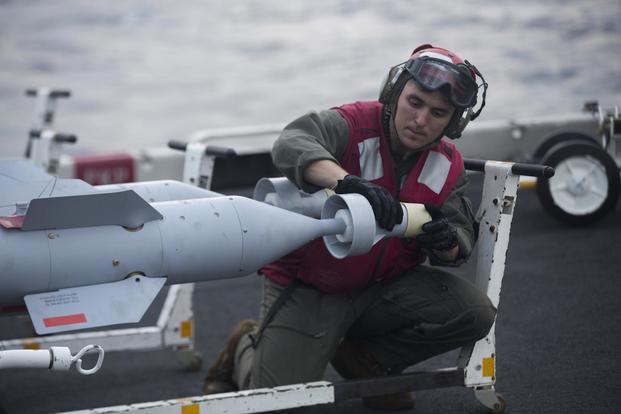Marines in the Pacific carried out the first-ever, at-sea F-35B "hot reloads" in that theater, allowing the aircraft to drop back-to-back 1,000-pound bombs on a target in the middle of the Solomon Sea.
Marines from the amphibious assault ship Wasp went to war last week with the "killer tomato," a big red inflatable target that was floating off the coast of Papua New Guinea. The Joint Strike Fighter jets left the ship armed with the 1,000-pound GBU-32 Joint Direct Attack Munition and a 500-pound GBU-12 Paveway II laser-guided bomb.
Once they dropped the bombs on the target, they returned to the Wasp where they reloaded, refueled and flew back out to hit the floating red blob again. It was the first-ever shipboard hot reloads in the Indo-Pacific region, according to a Marine Corps news release announcing the milestone.
Or as Chief Warrant Officer 3 Daniel Sallese put it, they showed how Marines operating in the theater can now "rain destruction like never before."
Related content:
- This Is the Marine Corps' 1st Female F-35B Fighter Pilot
- Marine F-35Bs Arrive on USS Wasp for First Shipboard Deployment
- F-35Bs Conduct Strikes in 'Beast Mode' for First Time in Pacific Region
- Marine F-35s Dropped a Bunch of Bombs on ISIS During 1st Middle East Deployment
"Our skilled controllers and pilots, combined with these systems, take the 31st [Marine Expeditionary Unit] to the next level," he said in a statement. "... My ordnance team proved efficiency with these operations, and I couldn't be prouder of them."
The aircraft, which are assigned to Marine Medium Tiltrotor Squadron 265 (Reinforced) and deployed with the MEU, also fired the GAU-22 cannon during the exercise. The four-barrel 25mm system is carried in an external pod on the Marines' F-35 variant.
The F-35Bs weren't the only aircraft engaging the "killer tomato" during the live-fire exercise. MV-22B Osprey aircraft and Navy MH-60S Sea Hawk helicopters also fired at the mock target.
The 31st MEU was the first Marine expeditionary unit to deploy with the F-35B. The aircraft has since had its first combat deployment to the Middle East, where it dropped bombs on Islamic State and Taliban militants.
-- Gina Harkins can be reached at gina.harkins@military.com. Follow her on Twitter @ginaaharkins.

















